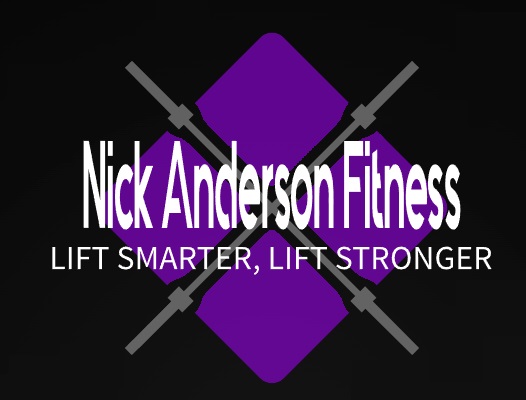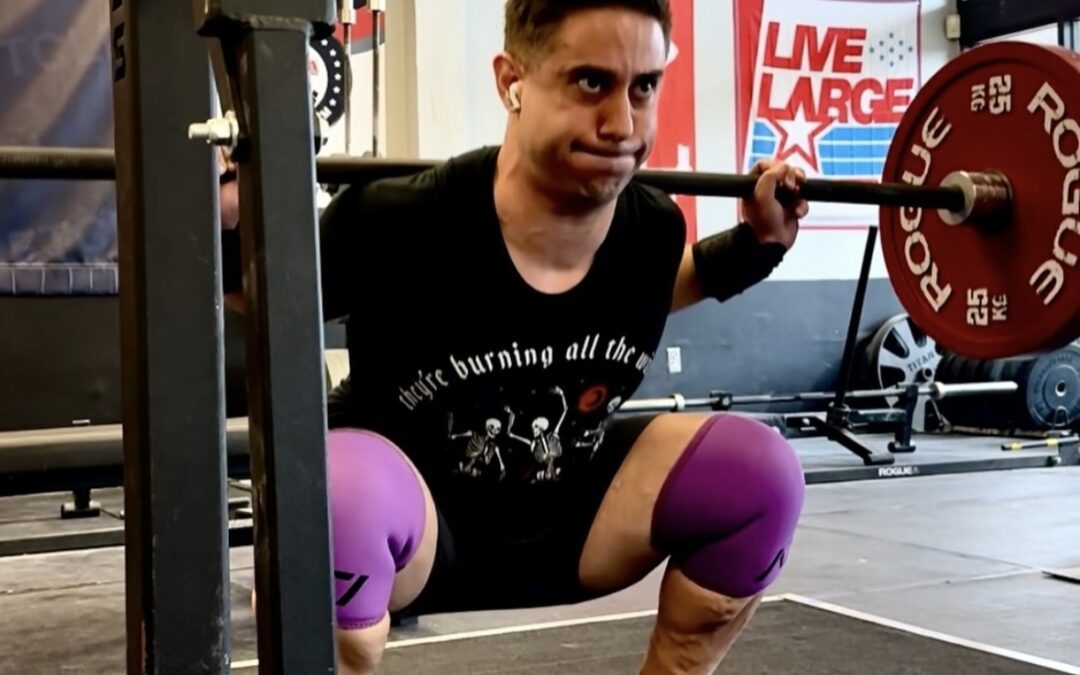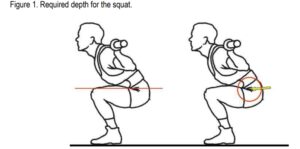Do you want to learn how to barbell back squat? You’ve come to the right place.
This is the most comprehensive guide on how to barbell back squat on the internet.
Whether you’re just getting into the gym for the first time, or you’re a competitive powerlifter.
I’m going to teach you everything you need to know about the barbell back squat.
You’ll learn how to do it in the safest possible manner so you don’t hurt yourself.
You’ll learn how to use it to build the most amount of muscle.
And you’ll learn to use the most optimal technique so you can lift as much weight as possible.
By the end of this article, you’ll know how to squat like a pro.
How To Do A Barbell Back Squat: A Step By Step Guide
Step 1 – Put the bar in the rack
Okay, no shit, Nick. Put the bar in the rack.
Obviously, but there is some nuance to it, and I want to make sure you get it right.
The height of the bar is everything.
It can be the difference between setting a massive personal record where everyone in the gym applauds.
And getting stuck at the bottom of the squat, and reaching frantically for your LifeAlert.
If you set the bar too high, you’ll have to get on tippy toes to get the bar out.
You don’t want to be standing on your toes with a lot of weight on your back.
Conversely, you don’t want to set up too low, as you’re wasting energy by already doing a partial squat just to get the bar off the rack.
When you set the bar up in the rack, you should be able to reach your hands out the bar, and your arms will be perfectly straight.
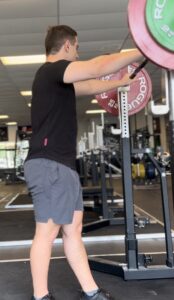
Not all squat racks will allow you to do this, as some have more space between height settings than others.
So whichever you can get closest to this position will generally work best.
But as a general rule, setting the bar too low is safer than setting the bar too high.
Step 2 – Get Under The Bar
Another obvious one, how are you going to barbell back squat without getting under the bar?
But again, there’s nuance to this, and it is arguably the most important piece of the barbell squat.
This is where you’ll initiate your setup, which is paramount.
So face the rack, and we can begin our setup.
Do not under any circumstances face away from the rack.
Otherwise, when you have to re-rack the bar later, you’re not going to be able to see the hooks, and you’ll have a much harder time reracking.
Shoulder Mobility
Start by putting your hands on the bar.
Where your hands can go will be dictated by your shoulder mobility.
The more mobile your shoulders are, the closer to the center of the bar your hands can go.
The less mobile your shoulders are, you’ll have to take a wider grip.
Ideally, you will want to have your hands as close as the mobility of your shoulders will allow.
This will allow you to create the most tension through your upper back to transfer force into the bar.
As long as your hands stay outside of your elbows once you get under the bar.

Where to place the bar on your back
Duck your head under, and get your shoulders under the bar.
You now have two options.
The high bar, or the low bar squat.
I’ll talk more about these later, but for now I just want to introduce how to setup.
For the high bar back squat, you’re going to place the bar across the top of your shoulders.
For the low bar back squat, you’re going to place the bar across your rear delts.
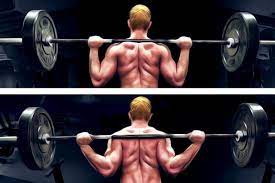
Step 3 – Get Tight
Now that you’re all cozy under the bar, it’s time to get uncomfortable.
The key here is to get everything in your body as tight and squeezed as possible.
The first thing I want you to think about doing is pinching your shoulderblades together, then down.
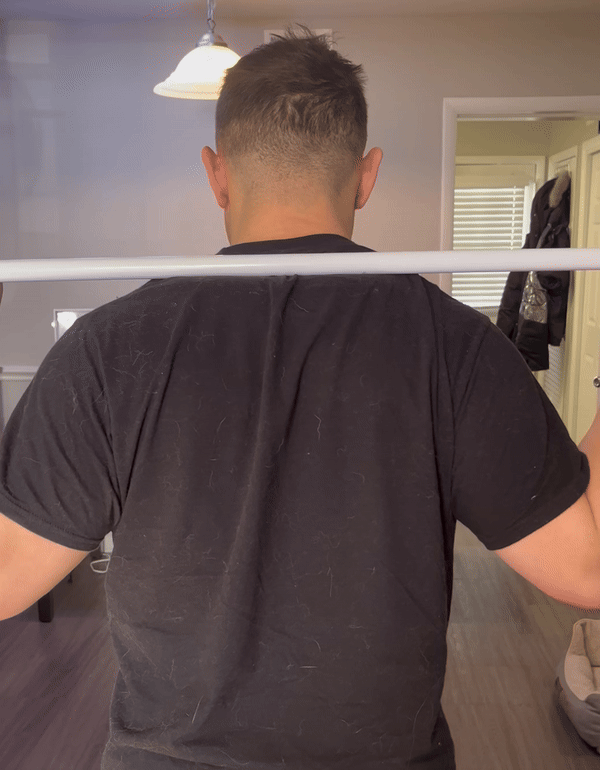
This is going to create a nice stable shelf for the bar to stay on the entire time.
Secondly, I want you to think about drawing your elbows back to your midline, then tuck them under you.
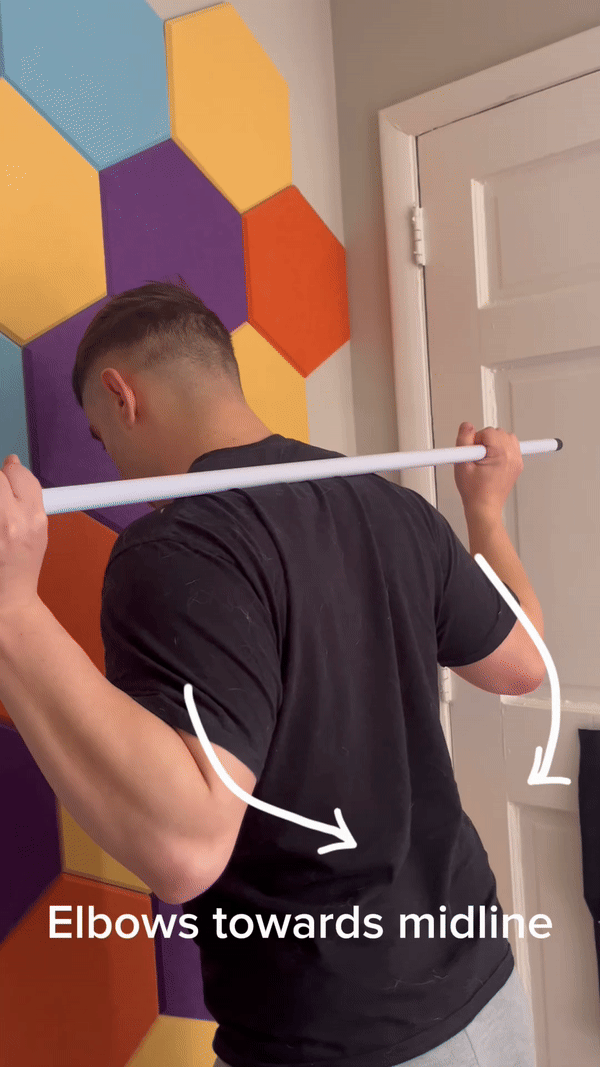
This is going to help engage the rest of your upper back and your lats.
The more muscles you have engaged, the less potential there is for energy to transfer into the bar, than leak out and cause your body to have to compensate elsewhere.
Step 4 – Walk Out
Now that you’re all nice and tight, it’s time to take this barbell for a ride.
Keeping everything tight and squeezed back towards your midline, stand all the way up, and take one step directly back behind you.
Many people will start stepping back and out to get their feet into their ideal position on the first step, but in my opinion, this is a huge mistake.
It leaves the potential for you to be off balance on your initial walkout.
And even worse, it also leaves potential for you to accidentally hit the rack with the bar, which will take you really off a balance.
So the first step to a good walkout is a single step straight back.
From here, you can step your opposite leg back and out to the side at an angle to set into your ideal stance width.
With your third and final step, step to the side to get even.
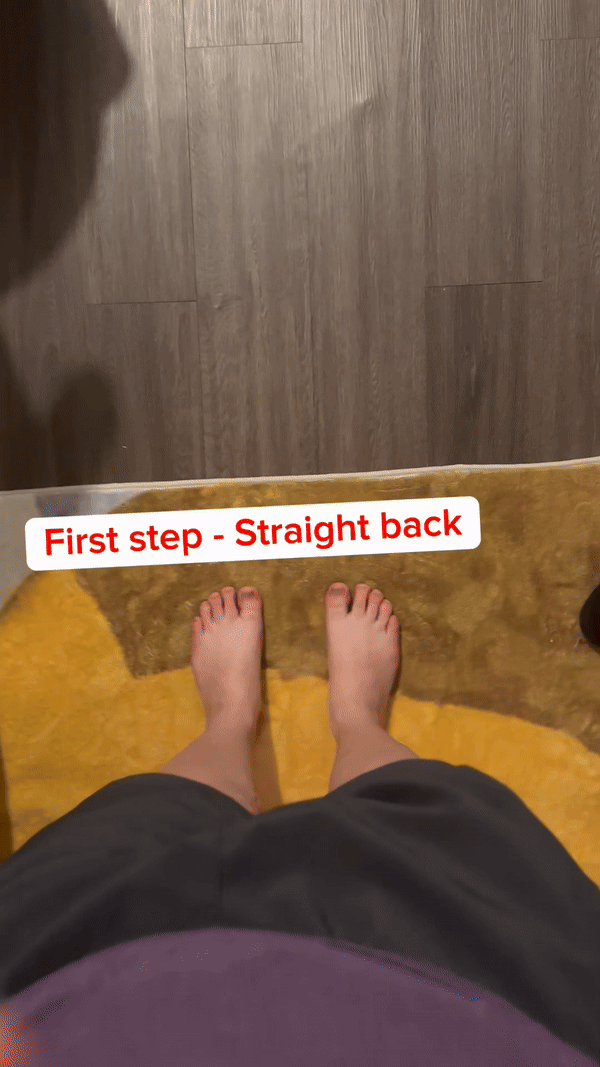
Setting your stance width
Just like your hand width on the bar, stance width is going to come down to individual variability.
The width of your stance will be dictated by factors such as ankle mobility, hip mobility, and limb proportions.
While there will always be exceptions to this rule, choosing either a super narrow, or a super wide stance is usually not ideal for most people.
Most lifters will feel most comfortable squatting with their feet slightly wider than hip width apart.
If you’re not sure of your most comfortable stance width, it is a great starting point.
As you continue to practice the squat, you can play with this position and test whether wide or more narrow than hip width feels better for you.
Make sure that when you play with your hip width, the angle of your toes follow the same angle as your knee.
For example, as you start to widen your hips for a wider stance squat, your toes will have to turn out to match the knee angle
And with a more narrow stance, your toes will have to turn more straight to match the knee angle
This image from an article by Barbell Rehab helps illustrate this point nicely
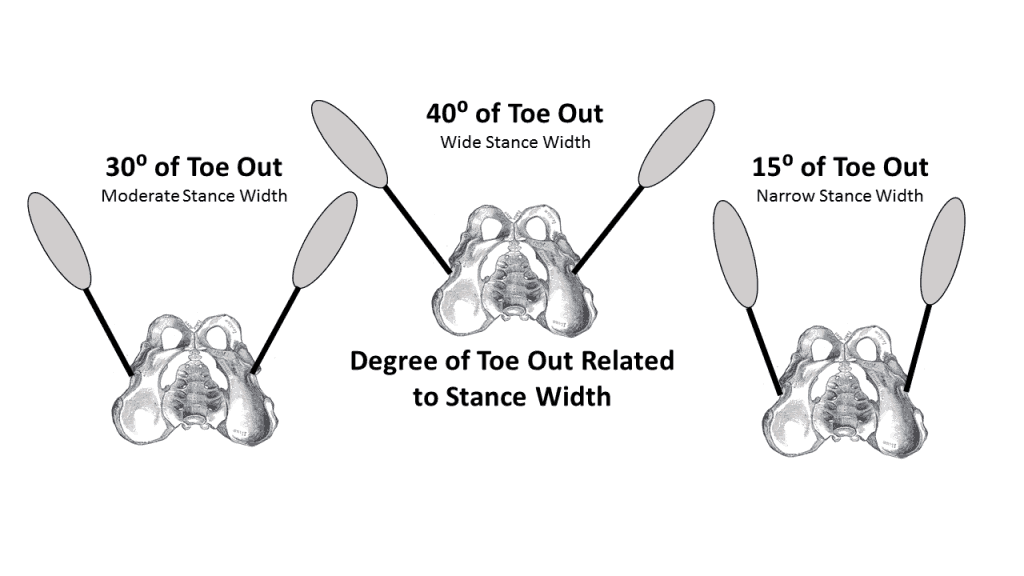
Step 5 – Breathing and Bracing
While this is one of the most important pieces of your squat, I’m not going to spend too much time on breathing and bracing.
Reason being, this could be it’s own separate article. In fact it is it’s own separate article entitled How To Brace Your Core For Lifting, which I highly recommend you read.
I’ll give you the too long didn’t read version in this article.
The foundations of a good barbell back squat comes from a giant breath in, and a big brace of your abdominal muscles.
The first step is to fill your body with as much air as possible.
Then brace your core by pushing your abdominal muscles out, like someone is about to punch you really hard in the stomach, and you’re bracing for impact.
The key is to get 360° of expansion across your entire midsection.
This is going to create intra-abdominal pressure, which causes your diaphragm to contract and press down into the empty space of your abdominal cavity, and creates pressure to support and stabilize the spine.
A good brace gives you not only your strongest lift, but your safest lift too.
If bracing isn’t a concept you’re all that familiar with, I’m going to reiterate the importance of reading How To Brace Your Core For Lifting.
Step 6 – Squat!
We finally got there, through a long series of setup, it’s time to squat.
You’ve got everything nice and tight, and you’ve braced the hell out of your core, your next step is to sit down into the squat.
Getting The Joints Working Together
Since the squat is a multi-joint movement, it’ll be necessary for you to move multiple joints at the same time (duh).
The reason I make this glaringly obvious statement, is with beginner squatters, or squatters with bad habits, I have seen the joints not move at the same time, but in series, one after the other.
The main joints involved in the squat are the ankle joint, the knee joint, and the hip joint.
As you descend, your hips move into flexion.
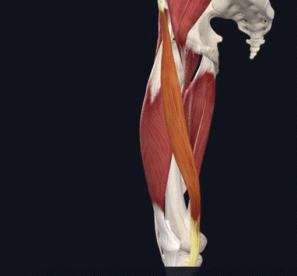
Your knees move into flexion.
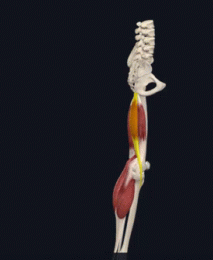
Your ankles move into dorsiflexion.
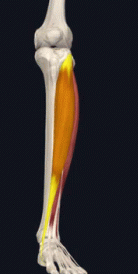
All three of these actions have to take place at the exact same time, otherwise, other muscles will take over, leading to a less efficient, and less safe squat.
The way that I like to cue lifters to get all these joints moving at the same time is to imagine a rope attached to each of these joints, pulling you in the direction needed.
Imagine a rope around the back of your ankles, pulling you forward.
Imagine a rope around the back of your knees, pulling you forward,
And imagine a rope around the front of your hips, pulling you backwards.
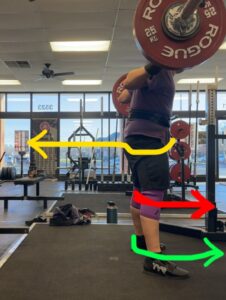
Tripod Foot
As you’re sitting down into the squat (and as you ascend as well), I want you to think about the tripod foot.
Which is not when a third foot comes out from your ass to help you balance.
It is maintaining equal pressure across three points of contact through your feet, the heel, the base of the big toe, and the base of the little toe.
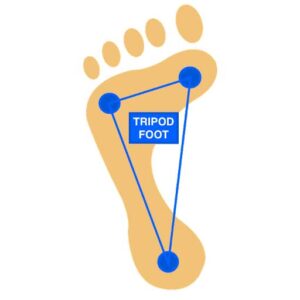
The first link in the chain of the squat is your feet.
Maintaining equal pressure across these three points of contact enhances the stability of your squat all the way up the chain.
So before you initiate your descent, I want you to first think about bringing attention the heel, the base of the big toe, and the base of the little toe.
If you are too far forward in your toes, your bodyweight will shift forward, causing you to be off balance.
And if you are too far back in your heels, your bodyweight will shift backwards, causing you to fall on your ass.
Focusing on these points distributes the pressure evenly through your feet, and brings force through the center of your foot, which is your center of mass.
Squat Depth
How deep you should squat depends entirely on the goals of your squat.
A full depth squat, according to the rules of powerlifting, is to get the crease of your hip lower than the top of your knee joint.
The above image credit from the USAPL Rulebook.
And if you are a powerlifter, or have aspirations to become a powerlifter, then you need to be able to hit this depth.
Non-powerlifters don’t necessarily need to squat this low, but there are several benefits to squatting this low.
If you can squat this low, without any pain, it is going to build up a lot of strength in your knee joints, and they will become healthier over time.
If you cannot squat this low without pain, you may be able to work up to it if you are following a good program, and under the guidance of a qualified coach.
You also might not be, and squatting to whatever depth your body can tolerate is perfectly acceptable, and still has great benefits.
Descend as quickly as your body can handle
Getting a good barbell back squat involves getting in quick and getting out quick.
The more time that you spend under the bar, the more tension from the weight is going to be placed on you, thus making the squat harder.
Now when I say that, many people initially think it means to dive bomb down into the squat at high speed.
For some of you, yes. For most of you, no.
I want to stress that I mean for you to go as quickly as you can handle.
Let’s use two examples of two of my online coaching clients and powerlifting athletes, Sahara, and Kate.
Example 1: Sahara
In the first example, Sahara is known to squat with what she describes as “lightning speed.”
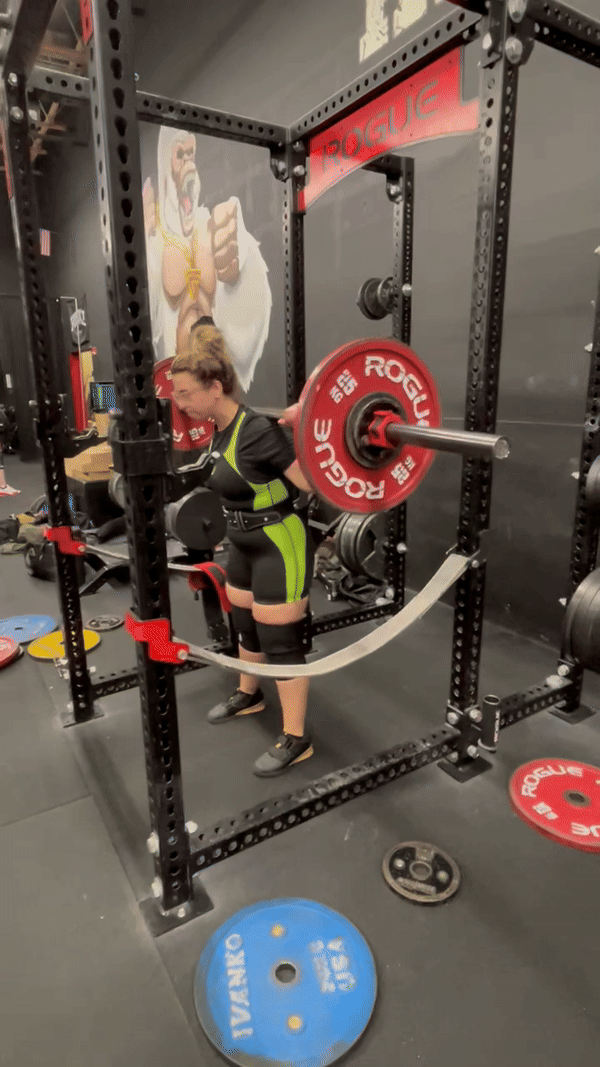
The reason for this is Sahara has really good balance.
She is evenly balanced in her limb lengths, which allows her to squat quickly without her technique breaking down.
Sahara also works in a group fitness setting, and is used to squatting quickly.
This makes her an outlier in how fast she squats.
Example 2: Kate
In the second example, we have Kate, you can see she moves much slower.
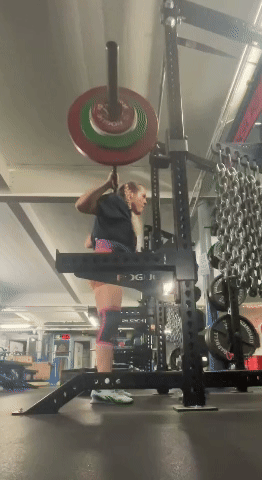
Since her limb lengths are less proportionate, and she has a longer upper leg compared to her lower leg and torso, it becomes difficult for her to squat as quickly (we will touch on the topic of limb lengths much more in depth later).
She also has tighter hips, making getting into the deepest position mare challenging.
If Kate we to try to squat down as quickly as Sahara, she would likely lose her balance, or lose tension somewhere through her body.
So she squats as quickly as her technique will allow, while still maintaining good technique.
Both Kate and Sahara are squatting as quickly as their body can handle, while still maintaining efficient technique.
While the two squats are significantly different speeds, they are both the most efficient squat for each individual.
So squatting quickly is important, but squatting quickly while maintaining tension in all the areas we talked about is more important.
If you squat quickly and lose your tripod footing, lose your squeeze of your shoulderblades, lose your brace, your speed is pointless.
Don’t sacrifice technique for speed of descent.
Step 7 – Ascend
The hard part, getting back up.
Once you hit that sweet spot at the bottom, you’re going to to push through your legs to stand back up.
Which sounds simple in theory, but when you have weight on your back, it’s easy for things to break down.
So let’s break it down so you don’t break down.
The bar should always stay over the middle of your foot
Throughout the entire movement for the barbell back squat, from unrack, to descent, to ascent, to reracking the bar, the bar should stay over the middle of your foot.
As we discussed in the tripod foot section, the center of your foot is your center of mass.
And if the big heavy thing on your back is shifted away from your center of mass, it creates a lever.
So then you have a see-saw effect, of trying to redistribute your weight back to keep the see saw from tipping over.
This means that every time you squat, the bar should move in a line straight up, then straight down.
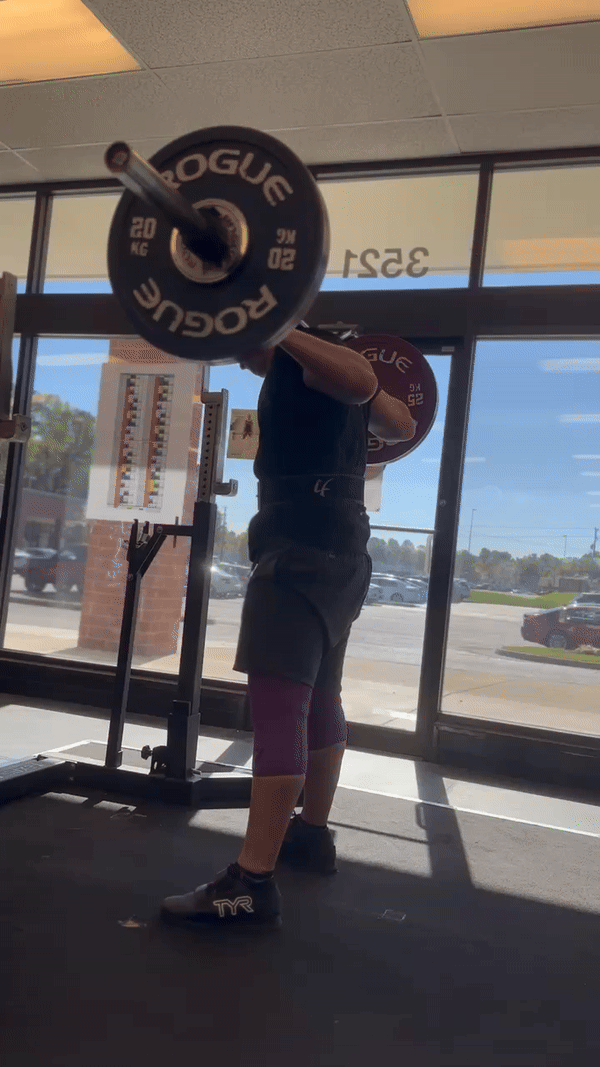
Fortunately, every technique piece you are learning in this article is going to help you to have the bar over the center of your foot the whole time.
Keep your knees in line with your toes
Remember how earlier I talked about how your toe angle should match your knee angle when you’re setting your feet?
As you squat, you should maintain that angle.
One cue I like to use with my online coaching clients is to corkscrew your feet into the floor.
Imagine there is a towel in between your feet, and without actually moving your feet, you’re actively trying to spread the towel apart.
This will help you ensure that your feet don’t roll to either side, which can be a very common cause of your knees coming inwards, and out of line with your toes.
I also want to mention that a common misconception is that your knees cannot pass your toes.
This is completely false, and as long as your heel stays planted on the floor, your knees passing your toes is perfectly fine.
Drive Your Shoulders Up Into The Bar
Driving your shoulders into the bar is a cue I like to use to to make sure that your body doesn’t fold over as you squat.
You can see this here from some early videos of my online coaching client and powerlifting athlete Christine.
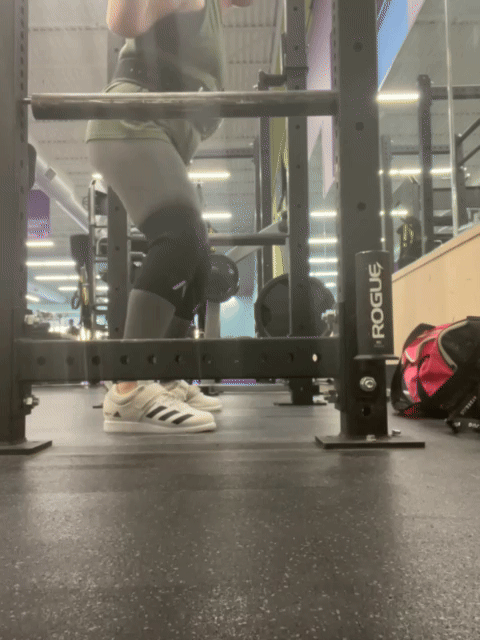
The first thing you’ll probably notice, is that as she initiates her ascent, her hips shoot up, and she’s no longer moving her knees and hips at the same time.
If you have a really keen eye, you might notice the second thing, which is her bar path becomes completely out of whack.
She has to use extra energy in order to right herself to keep from toppling over under the weight of the bar.
This can be due to weak muscles elsewhere in the chain, but most of the time, it’s going to be a technique issue.
In Christine’s case, it was an issue with technique, and the simple cue of “drive your shoulders into the bar” helped her keep her hips and knees moving at the same time.
It helped her keep her chest higher throughout the movement, and keep from folding over.
And best of all, it got her to be able to squat considerable more weight.
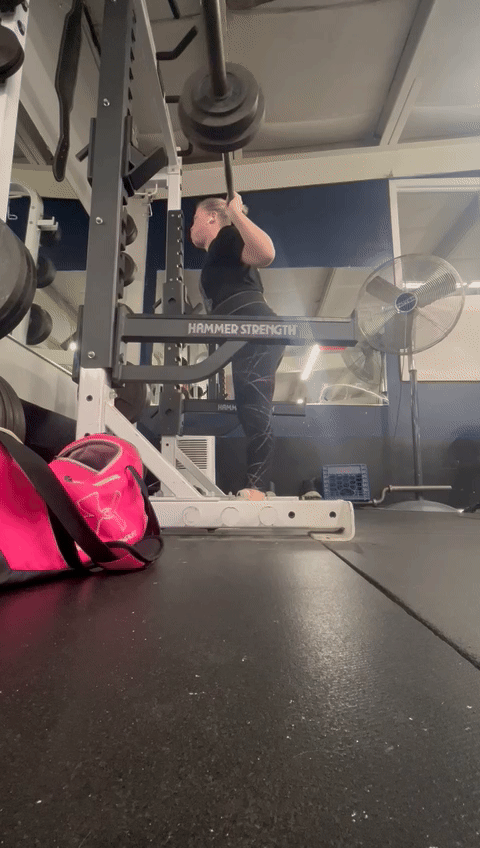
Step 8 – Rack
You did it! You squatted the bar, and you even stood up with it.
The bar didn’t crush you.
There’s only one problem, you still have this weight on your back, and you need to put it down.
While this may seem like a very simple step, it can be easy to screw up.
The trick I like to use with this is instead of looking side to side to try and find the hooks to rack the bar back onto…
Instead, walk to bar directly against the rack, and feel that both sides have hit the rack.
Then you can drop the bar onto the hooks, because you know both sides of the bar are already up against the rack, and not going anywhere
How To Do A Barbell Back Squat: Some Nuance You Should Know
Low Bar Squat vs. High Bar Squat
This is a topic that could probably use it’s own separate article.
I don’t have one just yet.
For now, I’m going to give you an overview on the difference between the low bar back squat and the high bar back squat.
The most obvious difference is where the bar sits on your back.
As mentioned way back at the beginning, the high bar squat rests the barbell across the top of your shoulders.
The low bar back squat rests the barbell across your rear delts.
But that’s not the only difference, because where you place the bar significantly changes how the movement is performed.
It changes what muscles activate more, it changes your posture in the squat, and it changes how much weight you can lift.
Who knew a matter of a few inches of bar placement can have such an impact.
High Bar Squat
With the high bar squat, the bar sits higher on your shoulders, which allows for a more upright posture.
Remember how the bar needs to stay over the middle of your foot at all times?
Well as you sink down into the squat with the bar up higher, it’s easier for you to maintain the upright posture while keeping the bar over your midfoot.
The upright posture is going to cause you to drive your knees forward more, which brings the knee joint further away from the bar.
The more horizontal distance between the knee joint and the bar, the greater demand it is going to place on your quadriceps.
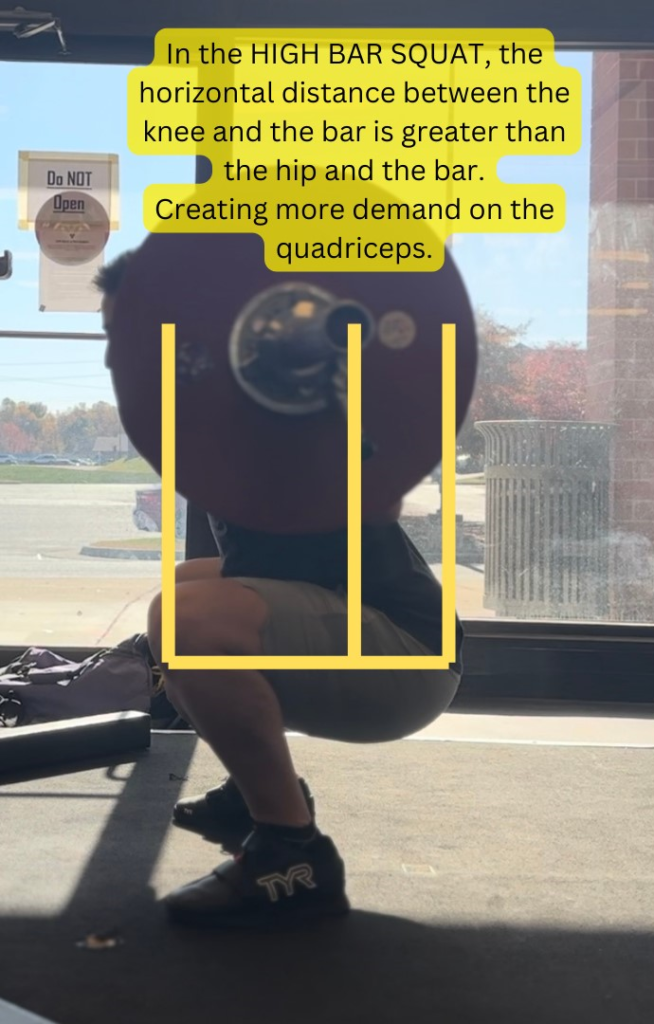
This makes the high bar squat more of a quad dominant exercise, and if you want to grow size and strength in your quads, it’s a great variation.
It is also a great variation if low bar squatting just doesn’t feel right for you.
Low Bar Squat
The low bar squat sits lower on your shoulders, which forces most lifters to lean forward more to maintain the bar over their midfoot.
Since you have to lean forward more, this creates more horizontal distance between the hips and the bar.
This places a greater demand on your posterior chain, otherwise known as all the muscles on the back of your body (glutes, hamstrings, spinal erectors, etc).
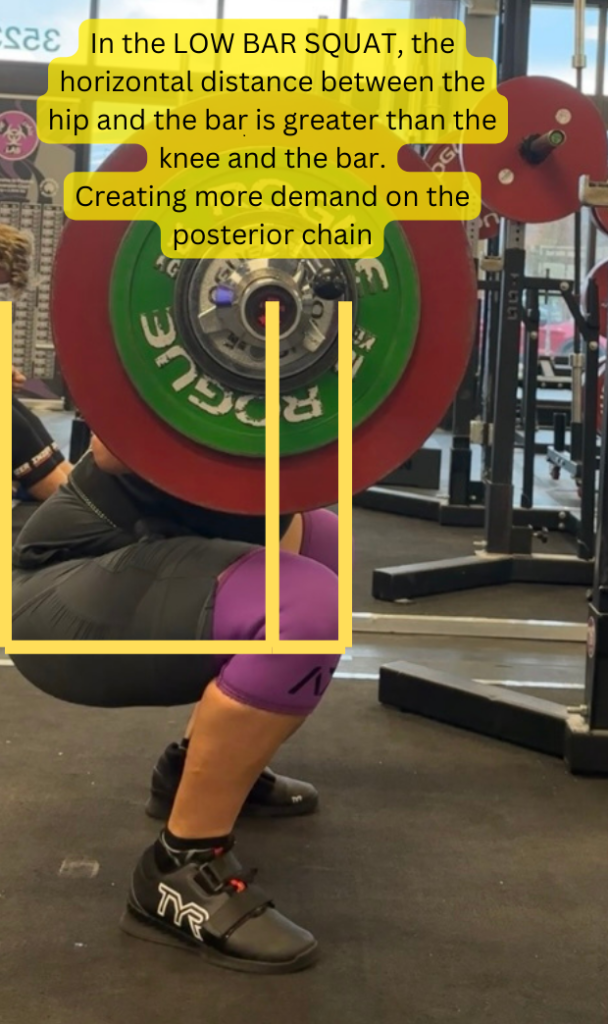
This makes the low bar squat more of a glute dominant exercise, and if you want to grow size and strength in your glutes, it’s a great variation.
It’s also a great variation if high bar squatting just doesn’t feel right for you.
Most lifters can lift more with the low bar squat than the high bar, as the posterior chain generally has more potential for strength than quads.
However, there are always exceptions to the rule.
Squat Anthropometry
Anthropometry is a super fancy word to describe measurements and proportions of the human body.
Everyone has different limb proportions, and in the squat, variation between people can make two squats look completely different, yet both are correct.
When it comes to the barbell back squat, the three areas to look at are at the lower leg, the upper leg, and the torso.
Torso length
- This refers to the length of your upper body, from the shoulders to the hips.
- Individuals with a longer torso may experience more forward lean during a squat, affecting the angle of their back.
- Those with a shorter torso might find it easier to maintain an upright position during a squat.
Upper Leg Length
- Upper leg length is the length of your thigh bone (femur), from the hip to the knee.
- Individuals with longer upper legs may need to lean forward more to balance the barbell over their midfoot.
- Shorter upper legs relative to the torso may allow for a more upright squat position.
Lower Leg Length
- Lower leg length refers to the length of your shin bone (tibia), from the knee to the ankle.
- Individuals with longer lower legs will have more forward knee movement in a squat..
- Shorter lower legs may have a different impact on knee movement and positioning during a squat.
For a more detailed overview on this topic this video by Dr. Brian Bochette explains this very well.
The most important takeaway from this, is that not everyone’s squat will look identical.
If you have a short torso, short lower leg, and a longer lower leg, your squat will be more upright.
If you have a long torso, long upper leg, and short lower leg, your squat will be leaned forward more.
Neither of these are wrong, it’s just the hand you are dealt.
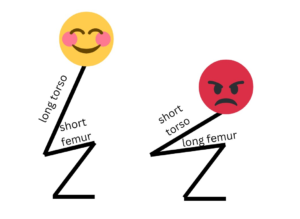
How To Do A Barbell Back Squat: Safety Tips
As with anything you do in the gym, there is a small amount of risk. But if you’re smart, and do everything you can to maximize your safety, the risk is extremely low.
Spotting
If you overestimate how much you can barbell back squat, you need a way to get out of it, in case you can’t stand back up.
This is where the role of a spotter comes into play.
The spotter can either be played by a person, multiple people, or the safety arms on your squat rack.
If you’re squatting with other people, you can have one person stand behind you.
In an emergency, they can grab your shoulders from behind, and assist you in getting back up.
You can also have one person stand on each end, and grab the plates to assist you back up.
If you’re squatting by yourself, setting the safety arms on your squat rack will help if you can’t get back up.
Set the arms just below what the bottom of your squat would be, and you can sit down and the arms will catch the bar.
I detail exactly how do this in this quick video clip
View this post on Instagram
How To Do A Barbell Back Squat: Closing Thoughts
Phew, that was a lot of information!
Like I said, this is the most comprehensive guide on the internet on how to barbell back squat.
So, I understand if the amount of information you’ve just received has overwhelmed you.
It’s important to remember that you’re not going to remember every single detail next time you go in to squat.
And even if you do remember every single detail, you’re not going to get it right the first time.
But, if you can use the information you’ve learned here to continuously improve, then this article has done its job.
Feel free to review the step by step process on how to barbell back squat over and over again.
If you found this guide helpful, but are looking for a more individual approach to perfecting not only the squat, but other lifts too, I am accepting new clients for online coaching.
Click the link above and we can have your lifts looking beautiful and stronger than they’ve ever been before.
Talk soon!
Nick
